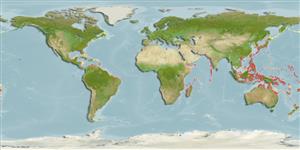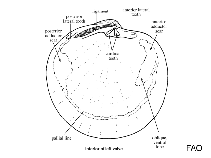Anodontia philippiana (Reeve, 1850)
Chalky buttercup lucine| Native range | All suitable habitat | Point map | Year 2050 |

|
| This map was computer-generated and has not yet been reviewed. |
| Anodontia philippiana AquaMaps Data sources: GBIF OBIS |
Google image | No image available for this species;
drawing shows typical species in Lucinidae.
Classification / Names आम नाम | उपशब्द | CoL | ITIS | WoRMS
Bivalvia | Lucinida | Lucinidae
Environment: milieu / climate zone / गहराई सीमा / distribution range पारिस्थितिकी
; खारा; गहराई सीमा 0 - 4 m (संदर्भ 8252). Subtropical
Distribution देश | ऐफ ऐ ओ क्षेत्र | Ecosystems | संयोग | भूमिका
Indo-West Pacific and Western Atlantic: from Red Sea and East Africa, through south east Asia and northern Australia to New Caledonia and Palau Islands. USA and Canada.
Length at first maturity / आकार / Weight / Age
परिपक्व अवधि: Lm ? range ? - ? cm Max length : 7.1 cm SHL पुल्लिंग / अलिंग; (संदर्भ 8252)
Life cycle and mating behavior परिपक्व अवधि | पुनरुत्पत्ति | मछलीऔ का अंडे देना | Eggs | Fecundity | Larvae
Main reference
संदर्भ | संयोजक | सहयोगीयो
Glover, E.A. and J.D. Taylor 2007 Diversity of chemosymbiotic bivalves on coral reefs: Lucinidae (Mollusca, Bivalvia) of New Caledonia and Lifou. Zoosystema 29(1):109-181. (संदर्भ 8252)
IUCN Red List Status
(संदर्भ 130435: Version 2025-1)
CITES status (संदर्भ 108899)
CMS (संदर्भ 116361)
Threat to humans
Human uses
| FishSource |
साधन
अधिक जानकारी
संघटक आहार
आहार खपत
परभक्षी
Max. ages / sizes
Length-weight rel.
Length-length rel.
Length-frequencies
Mass conversion
बहुतायत
इंटरनेट स्रोत
BHL | BOLD Systems | CISTI | DiscoverLife | FAO(Publication : search) | Fishipedia | GenBank (genome, nucleotide) | GloBI | Gomexsi | Google Books | Google Scholar | Google | PubMed | Tree of Life | Wikipedia (Go, खोज) | Zoological Record



